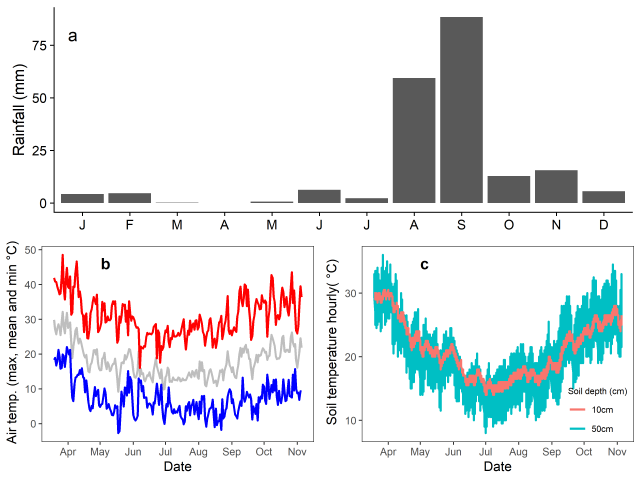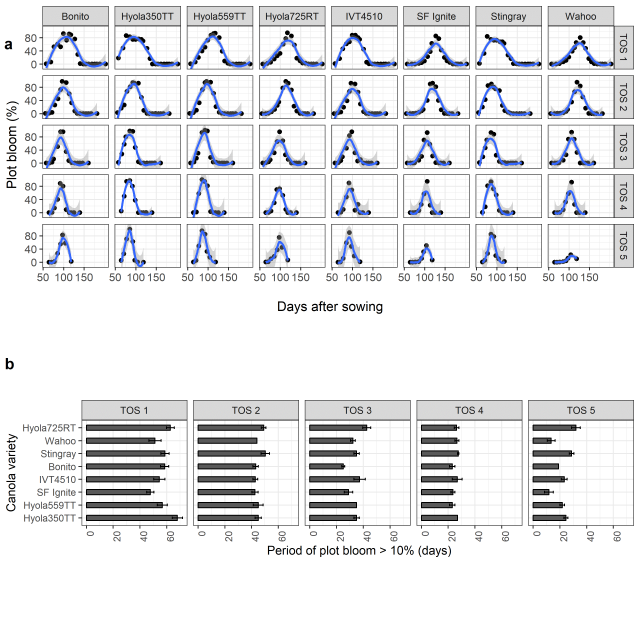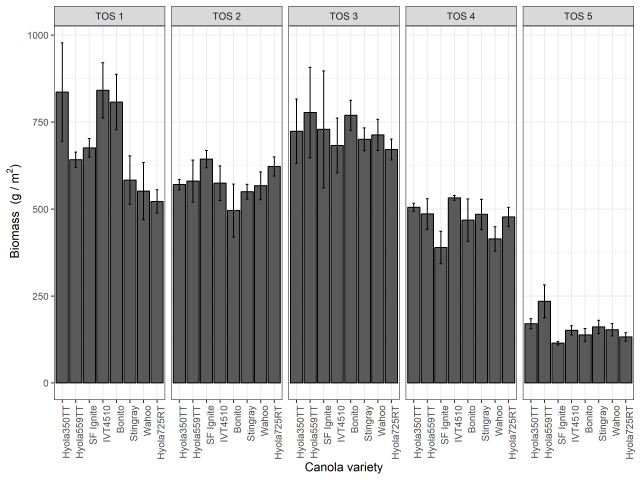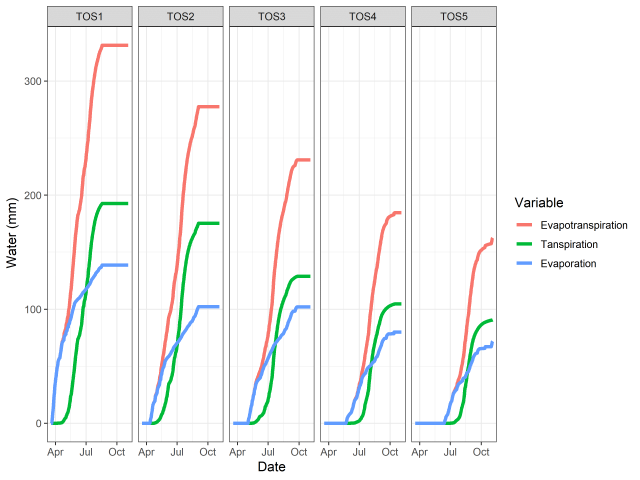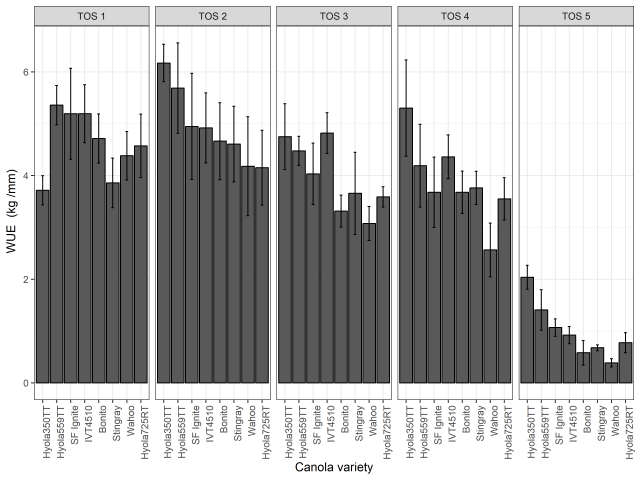Summary
Early crop establishment is key to maximising yield in this hot, short season environment
- Second week of April has worked well
- mid-March is too early
- Some canola varieties had substantial plasticity in growth and development such that a few varieties covered a wide range of emergence dates; a real benefit if dry sowing.
- Early flowering hybrids capable of branching into large plants are a good example of this and a good ideotype for this environment.
- These varieties have been adaptable in tough seasons and environments across different TOS.
- March sowing of canola is unlikely to be commercially successful due to difficulty establishing canola in hot conditions, short herbicide application windows and extra pest and disease pressures.
- Short season hybrids may reduce the risk associated with late emergence.
Background and Aim (aim clearly stated as the concluding sentence)
There is considerable interest in sowing canola early to maximise yield and minimise the risk of missing a sowing opportunity. Traditionally ANZAC day marked the date on which growers in Western Australia would start dry seeding. However, now growers in Western Australia’s Northern Agricultural Region are routinely sowing canola in mid-April.
The aim of these trials was to investigate yield and phenology of canola varieties when sown outside the traditional sowing window to provide better advice to agronomists and growers about the best varieties to use and safe sowing and flowering windows.
Trial details and treatments
The trial was conducted at Tenindewa, (18km west of Mullewa) on a red loamy sand. Plots were 10m long by 1.54m wide. Treatments included 8 varieties and five times of sowing (TOS) (March 19, April 9, April 30, May 21 and June 11). The varieties were all Triazine Tolerant and included both open pollinated and hybrid plant types of a wide range of season lengths: ATR Stingray (Early), ATR Bonito (Early/mid), ATR Wahoo (Late), Hyola 350TT(V.early) Bayer InVigor T4510 (Early), Hyola 559TT (Mid), SF Ignite (Mid/late), Hyola 725RT (Late). Varieties were blocked within times of sowing and there were 4 replicates. Plots were irrigated if needed for establishment and maintenance until the break of the season.
Meteorological data
Growing season rainfall was 194mm TOS 1, 189mm TOS 2, 186mmTOS 3, 186mm, TOS 4, 138mm TOS 5
We needed to irrigate all times of sowing except TOS5. TOS 1 and 2 were irrigated at least twice per week in March and April with 5-10mm to avoid soil drying in the hot conditions. Irrigation + rain:
TOS 1 388mm, TOS 2 330mm, TOS 3 277mm, TOS 4 221mm, TOS 5 138mm.
Yield
Averaged across all varieties yield of TOS1 was 1532 kg/ha, TOS2 1364 kg/ha, TOS3 915 kg/h, TOS4 717 kg/ha, TOS5, 160 kg/ha.
It should be noted that the earlier sowing times did receive more irrigation due to the very hot conditions at seeding and the late autumn rains, which caused higher rates evaporation and transpiration (Figure 6). We applied as much irrigation as was required to keep the plants reasonably healthy, to achieve the aim of seeing how canola performed if grown from sowing times outside the traditional seeding window. It was interesting to note that the new short season TT hybrids performed very well across a wide range of sowing dates (Figure 2). In particular June yields (TOS 5) were low but greater for early flowering hybrids at 350 kg/ha. The same occurred at the site in 2018 with short season hybrids yielding 850kg/ha when sown on June 20.
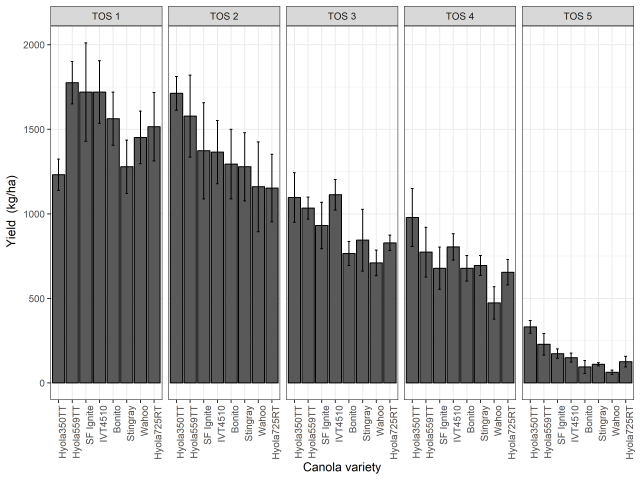
Establishment
Air temperatures spiked above 40°C until mid-April and soil temperatures remained high (Figure 1a, 1b). Consequently it was difficult to establish earlier sowing times (Figure 2). This highlights the risk of seeding such a small, shallow, seeded species into extreme heat conditions. In general a good break is needed to reduce soil temperatures and air temps around 40 degrees desiccated small seedlings, even in wet soil.
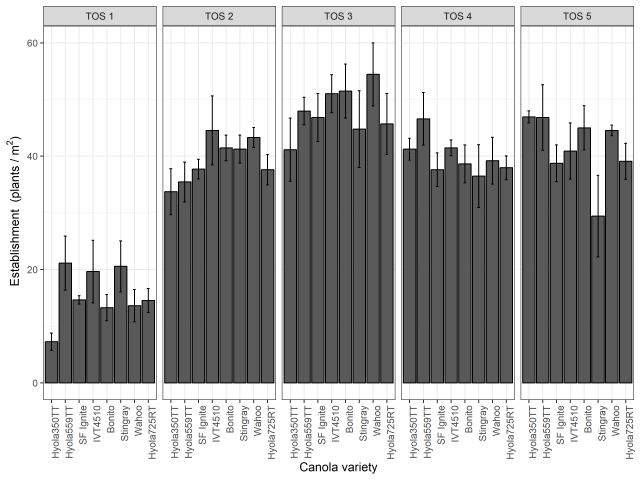
Development and growth
As sowing date was delayed the differences in flowering time of the varieties reduced, as would be expected (Table 1). From March 15 sowing the earliest varieties reached 50% of plants with flowers on the main stem by May 25 (67 Days after sowing) and latest varieties reached this stage on July 9 (112 DAS), such that there was 45 days difference between them. When plants were sown on June 11 the earliest varieties reached 50% of plants with flowers on the main stem by August 25 (86 DAS) and latest varieties reached this stage on September18 (110 DAS), such that there was only 24 days difference between them (Table 1).
One thing to consider is that the herbicide application window is short when sowing early. The earliest varieties started flowering at mid-May from March sowing and mid-June from April 9 sowing. Varieties tolerant to later herbicide applications may be a good tool to extend the window, i.e. varieties tolerant to glyphosate until flowering.
| TOS 1 | TOS 2 | TOS 3 | TOS 4 | TOS 5 | |
|---|---|---|---|---|---|
| Bonito | 13-Jun | 7-Jul | 26-Jul | 16-Aug | 9-Sep |
| Hyola 350TT | 25-May | 30-Jun | 10-Jul | 3-Aug | 25-Aug |
| Hyola 559TT | 23-Jul | 2-Jul | 21-Jul | 12-Aug | 31-Aug |
| Hyola 725RT | 4-Jul | 24-Jul | 29-Jul | 16-Aug | 8-Sep |
| IVT4510 | 12-Jun | 30-Jun | 26-Jul | 15-Aug | 2-Sep |
| SF Ignite | 9-Jul | 29-Jul | 5-Aug | 22-Aug | 18-Sep |
| Stingray | 1-Jun | 22-Jun | 10-Jul | 8-Aug | 31-Aug |
| Wahoo | 9-Jul | 2-Aug | 5-Aug | 23-Aug | 15-Sep |
Plants in the earlier sowing dates tended to flower for a longer period (Figure 4a). This was measured by assessing the period at which the plot bloom was greater than 10%. Some varieties such as Hyola350 flowered early but also had the capacity to continue branching and flowering such that they had a long flowering duration, i.e. 67 days from TOS1 (Figure 4b).
Plants sown earlier produced more biomass (Figure 5). Hyola350 was unable to compensate for a very low plant density from TOS1. This occurred because this cultivar emerged first and was grazed by kangaroos before netting was erected. However in general above 10 plant/m2 yielded well. At TOS 5 plants were unable to accumulate a large amount of biomass before the onset of terminal drought.
Water use efficiency (WUE)
Soil water interactions were simulated using APSIM to obtain estimates for evaporation and transpiration (Figure 6). The high evaporation rates in March make it unlikely that canola could be established well at this time in this environment. WUE was calculated using observed yields and predicted evapotranspiration (Figure 7). WUE was low for all sowing times reflecting the lack of finishing rains. For TOS 1 WUE was 4.6 kg/mm, TOS 2 4.9, TOS 3 4.0, TOS 4 3.9 and TOS 5 1.0. TOS 1 WUE was lower than TOS 2 due to higher evaporation and transpiration rates. TOS 5 WUE was low due to terminal drought severely reducing yield.
Conclusions
Early sowing is critical in this environment, but March is too early. The early and early-mid season maturity varieties showed the greatest plasticity in plant development across the sowing dates and may be a good option over a wide sowing period. Short season hybrids were quick to flower and produced substantial biomass. These plant types were well adapted across a wide emergence date and seem to be a good ideotype for this environment. While the plasticity in development of canola does lend itself to early sowing, extending the sowing window into early autumn is risky in northern areas due to hostile seed bed conditions. A deeper seeded species would need to be considered for this purpose.
Acknowledgements
Thanks to the Critch’s for hosting the trials for the past 2 years, seed companies for supplying seed in time for March sowing and Andrew Blake and Stephanie Boyce, Steve Cosh, Larry Prosser, Trevor Bell and Lucas Cooke for managing and monitoring the trial.
This trial was funded by DPIRD and GRDC through the Expanding the sowing window for canola and lupin project. The DPIRD project team includes Andrew Blake, Stephanie Boyce, Jackie Bucat, Helen Cooper, Imma Farre, Stacey Hansch, Marty Harries and Salzar Rahman.

